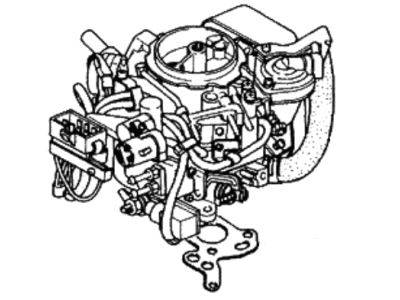A thorough road test and check of carburetor adjustments should be done before any major carburetor service work. Specifications for some adjustments are listed on the Vehicle Emissions Control Information (VECI) label found in the engine compartment. Carburetor problems usually show up as flooding, hard starting, stalling, severe backfiring and poor acceleration. A carburetor that's leaking fuel or covered with wet looking deposits definitely needs attention. Some performance complaints directed at the carburetor are actually a result of loose, out-of-adjustment or malfunctioning engine or electrical components. Others develop when vacuum hoses leak, are disconnected or are incorrectly routed. The proper approach to analyzing carburetor problems should include inspecting all vacuum hoses and actuators for leaks and correct installation, tightening the intake manifold and carburetor mounting nuts/bolts evenly and securely, performing a cylinder compression test, cleaning or replacing the spark plugs as necessary, checking the spark plug wires, inspecting the ignition primary wires, checking the ignition timing (following the instructions printed on the Vehicle Emissions Control Information label), checking the fuel pump pressure/volume, checking the heat control valve in the air cleaner for proper operation, checking/replacing the air filter element, checking the PCV system, checking/replacing the fuel filter. Also, the strainer in the tank could be restricted, checking for a plugged exhaust system, checking EGR valve operation, checking the choke-it should be completely open at normal engine operating temperature, checking for fuel leaks and kinked or dented fuel lines, checking accelerator pump operation with the engine off, checking for incorrect fuel or bad gasoline, checking the valve clearances and camshaft lobe lift, and having a dealer service department or repair shop check the electronic engine and carburetor controls. Diagnosing carburetor problems may require that the engine be started and run with the air cleaner off. While running the engine without the air cleaner, backfires are possible. This situation is likely to occur if the carburetor is malfunctioning, but just the removal of the air cleaner can lean the fuel/air mixture enough to produce an engine backfire.Overhaul: Once it's determined that the carburetor needs an overhaul, several options are available. If you're going to attempt to overhaul the carburetor yourself, first obtain a good quality carburetor rebuild kit (which will include all necessary gaskets, internal parts, instructions and a parts list). You'll also need some special solvent and a means of blowing out the internal passages of the carburetor with air. An alternative is to obtain a new or rebuilt carburetor. They are readily available from dealers and auto parts stores. Make absolutely sure the exchange carburetor is identical to the original. A tag is usually attached to the top of the carburetor or a number is stamped on the float bowl. It will help determine the exact type of carburetor you have. When obtaining a rebuilt carburetor or a rebuild kit, make sure the kit or carburetor matches your application exactly. Seemingly insignificant differences can make a large difference in engine performance. If you choose to overhaul your own carburetor, allow enough time to disassemble it carefully, soak the necessary parts in the cleaning solvent (usually for at least one-half day or according to the instructions listed on the carburetor cleaner) and reassemble it, which will usually take much longer than disassembly. When disassembling the carburetor, match each part with the illustration in the carburetor kit and lay the parts out in order on a clean work surface. Overhauls by inexperienced mechanics can result in an engine which runs poorly or not at all. To avoid this, use care and patience when disassembling the carburetor so you can reassemble it correctly. Because carburetor designs are constantly modified by the manufacturer in order to meet increasingly more stringent emissions regulations, it isn't feasible to include a step-by-step overhaul of each type. You'll receive a detailed, well illustrated set of instructions with any carburetor overhaul kit; they will apply in a more specific manner to the carburetor on your vehicle.
Posted by HyundaiPartsDeal Specialist 




